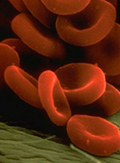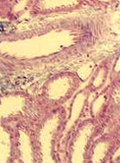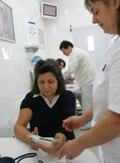The eLitMed.hu medical portal uses computer cookies for convenient operation. Detailed information can be found in the Cookie-policy.
Hypertension and nephrology - 2013;17(02)
Content
[Hypertension and diabetes mellitus]
[Hypertension and diabetes mellitus are endemics which affect large crowds; they play an important role in the morbidity and mortality of the population. Both diseases are cardiovascular risk factors, their co-occurrence increases the coronary risk. According to forecasts, there will be 60% increase in the number of hypertensive patients by 2025; it will affect 29% of the world’s adult population, 1.56 billion people. The number of patients with diabetes increases in all countries; 552 million diabetic patients should be expected by 2030. The simultaneous occurrence of both diseases may be a coincidence, but there is also causal relationship between the two diseases (diabetic nephropathy, metabolic syndrome). The two diseases often occur in endocrine diseases, and in connection with medicinal therapy (steroids, etc.). The simultaneous occurrence of these two diseases determines the therapeutic strategy. During the prevention and treatment of both diseases, the change in lifestyle has an important role (obesity, salt intake, physical activity).]
[Goals, doubts and confidences in treatment of renal anemia]
[The authors sum up the physiology of erythropoiesis, the history of the erythropoietin’s discovery and the steps through which it became applicable to clinical adaptation. The biologically similar erythropoietin medicines and their application are reviewed. The setting of the target hemoglobin value and the weekly amount of erythropoietin needed for successful therapy are briefly surveyed. The authors draw attention to the fact that by increasing the dose the risk of mortality rises. Considering the other side effects they conclude based on international data and studies that “less is more” in this case namely the lower target value and erythropoietin dose can mean bigger therapeutic success. The erythropoietin treatment’s practice in Hungary is expressly efficient in the authors’ view.]
[Practical aspects of therapy by erythropoiesis stimulating agents in renal anaemia]
[Prevalence of renal anaemia due to insufficient production of erythropoietin increases progressively in the course of renal function deterioration. Renal anaemia is treated by erythropoesis stimulating agents (ESA). Outcomes of randomized clinical trials have taught us to avoid the strategy of normalization of hemoglobin (HGB) levels by ESA therapy as it may increase the risk of cardiovascular events and mortality. The Kidney Disease: Improving Global Outcomes (KDIGO) Clinical Practice Guideline for Anaemia published in 2012 recommends to start ESA therapy in the 90-100 g/l HGB range and suggests to keep HGB concentrations below 115 g/l. It is an inappropriate strategy to aim at normalizing hemoglobin (HGB) levels by ESA therapy because it may lead to progressive escalation of ESA doses even in the presence of diminished ESA responsiveness. High ESA doses and diseases causing ESA hyporesponsiveness eg. infections, chronic inflammation, malnutrition, insufficient dose of dialysis, severe hyperparathyroidism, iron deficiency are related to increased risk of mortality. KDIGO Clinical Practice Guideline for Anaemia emphasizes the importance of assessing and treating causes of ESA hyporesponsiveness, limits ESA dose escalation and recommends gradually changing ESA doses to avoid high amplitude HGB oscillation.]
[Monitoring of the blood pressure lowering effectiveness of ramipril-amlodipine fix combination – a non-interventional trial (RAMONA study)]
[Purpose: Monitoring the effectiveness and safety of the fix combination formulation Egiramlon® therapy containing ramipril and amlodipin in patients, suffering from mild or moderate hypertension despite antihypertensive treatment. Patients and methods: Open, prospective, phase IV clinical observational study, which involved 9169 patients (age >18) with mild or moderate hypertension [TUKEB No: 16927- 1/2012/EKU (294/PI/12.)]. Ramipril/Amlodipin 5/5, 5/10, 10/5, 10/10 mg combinations were administered/ titrated in three visits, during the four months period according to the physician’s decision Blood pressure was measured by validated blood pressure sphygmomanometry and ABPM (Meditech, Hungary). The dosis of the fix combination formulation was determined individually during the visits by the 923 doctors involved in the study. The target blood pressure value was 140/90 mmHg, but in case of high risk patients population (diagnosed cardiovascular disease, diabetes), 130/90 mmHg target value was determined. Results: In 70.1% of the patients had no protocoll deviation. Patients data and examination results were processed according to this 6423 patient population. The average age of the patients were 60.2 year, in 50-50% sex distribution. The average duration of the treated hypertension was 9.8 years and the average blood pressure value was 157/91 mmHg. Till the end of the study, systolic blood pressure has decreased with 26.4 mmHg and diastolic pressure with 11.8 mmHg. An average 5.5 bpm heart rate frequency decreasing was observed at the end of the study. As a result of the treatment 52.4% of the patient population has reached the target blood pressure value.]
[Health Protective Screening Program of Hungary 2010-2020. Metabolic syndrome - Results in 2010-2012]
[1 597 163 health assessments were performed on 65267 persons as a part of screening program. 132 964 participants were participated in our lifestyle advice program. The number of questionnaire responses for health statue were 3 717 480 during three years. This publication presents the results of metabolic disorders explored by screening. The metabolic syndrome was characterized by visceral obesity, abnormal glucose level and elevated blood pressure. Reasonable suspicion of metabolic syndrome was occured in 33-38% of subjects. Where the positive criteria was present, there were higher values of investigated parameters (waist, glucose, cholesterol, systolic blood pressure, uric acide level) compared with those of negative criteria.]
[Managing hypertension using a fixed combination of an angiotensin converting enzyme inhibitor and a calcium channel blocker]
[The objective of the study was to compare the efficacy of a low-dose combination of an angiotensin-converting enzyme (lisinopril 10 mg) and a dihydropyridine calcium channel blocker (amlodipine 5 mg) (Ekvator, Gedeon Richter) (Group 1) and enalapril with or without hydrochlorothiazide (Group 2) in hypertension. Materials and methods: The study included 93 patients with hypertension (36% of men and 64% of women). The mean age was 52.6±12 years and the mean duration of hypertension was 7.5±6.1 years. The initial office blood pressure (BP) was 149.2±13.8/91.4±81 mmHg. Patients were randomized into two groups (Group 1, n=51 and Group 2, n=36). Results: The fixed-dose combination of amlodipine/lisinopril offered the potential to reduce the office BP by -28.9±11.3/-16.0±8.7 mmHg; p<0.0001. In Group 2 the office BP dropped by -22.9±17.9/-11.5±10.7 mmHg; p<0.0001. Patients in Group 1 achieved goal blood pressure more frequently than patients in Group 2 (94.1% versus 72.2% patients respectively; p=0.008). There were no significant changes in the heart rate in either group. The reduction of microalbuminuria (the reduction in urinary albumin excretion (UAE)) by -13.8±24.4 mg/24h (p<0.001) was observed only in patients from Group 1. The quality of life of patients from Group 2 improved. However, the quality of life improvements were more significant in Group 1 than in Group 2 (p=0.002). Conclusion: The fixed-dose combination of amlodipine/lisinopril offers the potential to achieve a target blood pressure in 94% of patients with hypertension, produces a nephroprotective effect and improves patients’ quality of life.]
[What you need to know about the influence of abnormal lipid profiles. - New experiences]
[Statins represent the most important drug among antilipidemic therapy modalities playing dominant roles against atherosclerotic burden. Statin’s outstanding importance is due partly to cholesterol lowering capacity, however their anti-inflammatoric, antiproliferative, antioxidant and vasodilatative efficacies as a pleiotropic potential indicates much more impact on prompt retardation of atherosclerotic progression. The results concerning statin pleiotropic influence are reviewed which are in association with their new indication in ACS management. The second part of this review delineates suspected side effects of statin use. Only one concern brings safety information: it is a fact that patients being treated with statins may have a small increased risk of increased blood sugar levels and of being diagnosed with type 2 diabetes mellitus, but the cardiovascular and mortality benefits of statin therapy exceed the diabetes hazard.]
1.
Clinical Neuroscience
Is there any difference in mortality rates of atrial fibrillation detected before or after ischemic stroke?2.
Clinical Neuroscience
Factors influencing the level of stigma in Parkinson’s disease in western Turkey3.
Clinical Neuroscience
Neuropathic pain and mood disorders in earthquake survivors with peripheral nerve injuries4.
Journal of Nursing Theory and Practice
[Correlations of Sarcopenia, Frailty, Falls and Social Isolation – A Literature Review in the Light of Swedish Statistics]5.
Clinical Neuroscience
[Comparison of pain intensity measurements among patients with low-back pain]1.
Clinical Neuroscience Proceedings
[A Magyar Stroke Társaság XVIII. Kongresszusa és a Magyar Neuroszonológiai Társaság XV. Konferenciája. Absztraktfüzet]2.
3.
Journal of Nursing Theory and Practice
[A selection of the entries submitted to the literary contest "Honorable mission: the joys and challenges of our profession" ]4.
Journal of Nursing Theory and Practice
[End of Life and Palliative Care of Newborns in the Nursing Context]5.
Journal of Nursing Theory and Practice
[Aspects of Occupational Health Nursing for Incurable Patients ]









